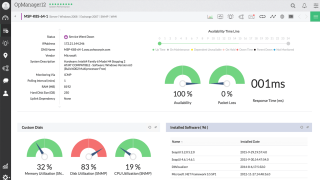9 من أفضل أدوات استكشاف أخطاء الشبكة وإصلاحها التي قمنا بمراجعتها في عام 2021

استكشف مجموعة مختارة من أفضل أدوات استكشاف أخطاء الشبكة وإصلاحها من أجل تقدير شامل للأداء وتحسين التفاعل مع الشبكة.
IIS ، اختصارًا لخدمات معلومات الإنترنت ، والمعروف سابقًا باسم Internet Information Server ، هو خادم ويب من Microsoft تم تصميمه للاستخدام مع منتجات Windows ، بدءًا من عائلة NT.
يتم استخدام خادم الويب هذا لمساعدة مستخدمي Windows على استضافة أنواع مختلفة من المحتوى على الويب ، مثل ملفات الوسائط أو المستندات أو حتى مواقع الويب الكاملة. في الوقت الحالي ، يعد Apache أكثر خادم ويب Windows شهرة ، ويليه IIS عن كثب ، وهو أمر مثير للإعجاب.
ما هو IIS؟
IIS هو خادم ويب يسهل التعرف عليه ، وذلك بفضل واجهة المستخدم الرسومية البديهية (GUI) التي تتيح لك إدارة مواقع الويب المرتبطة بالخدمة والمستخدمين المرتبطين بها . تجعل واجهة المستخدم الرسومية الخاصة بـ IIS من السهل تصميم مواقع الويب وتخصيصها وتكوينها ونشرها من مكان واحد.
يحتوي على أداة مدمجة لإدارة مواقع الويب تسمى IIS Manager والتي يمكنك استخدامها لضبط الخيارات مثل إعدادات الأمان ، ومعلمات الأداء ، وتفضيلات التسجيل ، بالإضافة إلى صفحات الخطأ أو القيم الافتراضية لمواقع الويب التي تديرها.
من وجهة نظر فنية ، يعتبر IIS متعدد الاستخدامات تمامًا ، حيث يرى أنه يمكن أن يخدم صفحات الويب القياسية والديناميكية على حد سواء ، دون بذل جهد كبير. وبالتالي ، يمكنك استخدامه لإنشاء صفحات ويب بتنسيق HTML ونشرها ، ولكن من الجيد معرفة أنه يمكنك أيضًا إدارة صفحات PHP وتطبيقات ASP.NET.
بفضل مرونته ، يمكن لـ IIS تشغيل البرامج النصية والتطبيقات الموجودة في صفحات الويب الديناميكية وعرض النتائج على شاشة متصفح الويب الخاصة بالزائر. مع مواقع الويب الثابتة ، تكون العملية أسهل: يرسل IIS محتوى HTML والصور (إن وجدت) إلى متصفح الويب الخاص بالزائر.
ما هو هدف معهد الدراسات الإسماعيلية؟
نظرًا لأنه يستفيد من دعم Microsoft الكامل ، وحقيقة أنه يشتمل على العديد من الميزات المتقدمة ، فإن IIS يعد خيارًا رائعًا لإنشاء مواقع الويب التجارية وإدارتها ، مثل المتاجر الإلكترونية أو مواقع الويب الخاصة بالمحفظة الترويجية.
الجانب السلبي هو أن استخدام IIS لأغراض تجارية يعني أيضًا أنك ستحتاج إلى ترخيص تجاري. علاوة على ذلك ، يختلف سعر هذا النوع من الترخيص اعتمادًا على عدد المستخدمين الذين تريد تضمينهم.
لقد أثبتنا بالفعل أنه يمكن استخدام IIS لإنشاء موقع ويب واستضافته ، بالإضافة إلى حقيقة أنه يدعم محتوى الويب الثابت والديناميكي. ومع ذلك ، فإن IIS أكثر من ذلك بكثير. على سبيل المثال ، يمكنك استخدام دعم الوحدة النمطية المدمج بها لتحسين وظائف الخادم الخاص بك.
من الممكن تثبيت وحدات البث على الخادم الخاص بك حتى يتمكن زوار موقع الويب الخاص بك من الاستفادة من تدفق محتوى الوسائط. يمكنك أيضًا استخدام وحدة إعادة كتابة عناوين URL التي تمكّنك من إنشاء قواعد تنفيذ فعالة لعناوين URL بحيث يمكن للزوار تذكرها بسهولة ويمكن لمحركات البحث العثور عليها بشكل أسرع.
لذلك ، من نافلة القول أنه إذا كنت بحاجة إلى طريقة سريعة لإنشاء موقع ويب ونشره ، فإن IIS هو أحد أفضل الطرق للقيام بذلك. لا تزال أفضل طريقة هي Apache HTTP بفضل كونها مفتوحة المصدر وتسمح لك باستخدامها مجانًا ، بغض النظر عن عدد المستخدمين.
محفوظات إصدار IIS
من الجدير بالذكر أنه في البداية ، كان المقصود من IIS أن تكون بديلاً لخادم الويب الذي تم تطويره كمشروع بحثي. تم توزيع أول مشروع خادم ويب موقع من Microsoft كبرنامج مجاني وصُمم لـ EMWAC (المركز الأكاديمي الأوروبي لـ Microsoft Windows NT).
ومع ذلك ، نظرًا لأن خادم EMWAC لا يمكنه التعامل مع كل حجم حركة المرور التي كانت تنتقل إلى موقع microsoft.com ، فقد تم إسقاط المشروع وطوّرت Microsoft خادم الويب الخاص بها في شكل IIS.
أحد الجوانب الملحوظة هو أن معظم إصدارات IIS تم إصدارها مع أو بجانب إصدار من نظام التشغيل Windows. بالتأكيد ، كان معهد الدراسات الإسماعيلية في ذلك الوقت مجرد ظل لكيفية معرفتنا به اليوم ؛ في الواقع ، يمكن أن يعمل كل إصدار من Windows بشكل جيد كنقطة تفتيش لتطور IIS.
إذا كنت تخطط لاستخدام IIS ، فحاول التمسك بأحدث إصدار مستقر ، لأنه عادةً ما يكون هو الأكثر أمانًا ويحقق أفضل النتائج الموجهة نحو الأداء ، خاصةً إذا كنت تقوم بتشغيل أحدث إصدار من Windows أو Windows Server.
كيفية تثبيت IIS؟
كما ذكرنا سابقًا ، لست بحاجة إلى تثبيت IIS ، حيث يجب أن يأتي مدمجًا مع إصدار Windows الخاص بك. إذا كنت تستخدم Windows 10 ، فيجب أن يكون لديك بالفعل بعض إصدارات IIS 10.0 المتوفرة على جهاز الكمبيوتر الخاص بك.
However, Microsoft decided not to activate IIS by default, so you’ll need to enable it manually. But don’t worry, it’s not exactly rocket science to get this done. Just follow these steps to activate IIS on your PC:
Now you may want to restart your PC so that your system can load all required configuration files and let you use IIS to its full extent. It may also work without restarting your PC, but rebooting your system after enabling a new feature is never a bad idea.
You can also enable IIS on your computer by using PowerShell. If you never heard of it, PowerShell is a complex tool that many mistake for CMD. PowerShell is way more complex than that, but we won’t get into too much detail. Without further ado, here’s how you can enable IIS on your Windows PC using PowerShell:
Enable-WindowsOptionalFeature –online –featurename IIS-WebServerRoleAs you can see, PowerShell hints that no restart is required after enabling IIS on your Windows 10 PC. If you want to rever the process, you can use the following command to disable IIS using PowerShell:
Disable-WindowsOptionalFeature –online –featurename IIS-WebServerRoleHowever, note that for disabling this feature, even PowerShell recommends that you restart your PC. It’s also possible to restart it later, just don’t start any new projects in the meantime.
How does the IIS server work?
First and foremost, it’s worth noting that IIS has its own process engine that can take care of all client-server requests. Therefore, whenever a client sends a request to your web server, IIS processes that request, generates a reply, and sends it to the client.
From an architectural standpoint, this process unfolds on two different layers:
As we’ve mentioned above, you can find HTTP.SYS in the Kernel Mode. HTTP.SYS is used to forward client requests to an application pool. This request forwarding process is initiated whenever the client interacts with the web site’s URL, attempting to access the page. Whenever this happens, HTTP.SYS retrieves the client’s requests and queues them for specific application pools.
After the forwarding of the request, w3wp.exe (the Worker Process) loads the ISAPI filter and either loads HttpRuntime.ProcessRequest by itself, or in conjunction with aspnet_isapi.dll if it’s an ASPX page. The launch of HttpRuntime.ProcessRequest marks the beginning of the processing, after which the HttpRuntime process uses HttpApplication objects to build a pool, the contents of which will be passed through HTTP.
The HTTP modules are then activated, and this process goes on until the request gets to the ASP.NET page’s HTTP handler. After the request gets through the HTTP route, the page starts to be displayed.
What is the Worker Process?
First of all, it’s worth noting that there’s not only one Worker Process. In fact, there are several such entities that ensure the well-functioning of your web server and the content you host on it, whether it’s websites or applications we’re talking about.
So, IIS’s worker processes are in charge of providing us with the execution environment for all applications and websites you’ve previously configured in the IIS. These processes contain several pieces of information that are crucial to the well-functioning of the aforementioned services.
It’s possible that you can make use of the API to retrieve information regarding memory footprint or CPU utilization. These details can help you keep a close eye on the overall health of your web server and its related worker processes.
Last, but not least, you can use the API to terminate worker processes by simply sending a DELETE request to the worker processes endpoint.
What is the Application Pool?
Although the name is somewhat self-explanatory, the purpose of IIS’s Application Pool is far more complex. First and foremost, the Application Pool contains the worker processes, so it’s safe to say that it plays the role of a container. Furthermore, it isolates applications from each other whether they run on the same server or on separate ones, which is contrary to how a pool usually works.
It’s quite important to know that a single application pool can hold several websites. So, in other words, you can say that an application pool is but a set of URLs that have been handled by worker processes. The separation of applications in these pools is justified by the fact that it could significantly simplify management. More so, it is because of this isolation that, in the event of one application pool failing, the other ones can keep going on as usual.
How to configure an IIS server?
You’ve enabled IIS on your computer and you’ve learned a bit about its components, now let’s see how you can properly configure it so you can run your own web server without significant efforts.
As we mentioned a while back, one of the main reasons why people use IIS is for easy web application deployment. IIS and its Advanced Installer feature allow you to configure and deploy web apps on several servers without skipping a beat. You also don’t need to create new configurations for each machine, as IIS can easily take care of that.
If you want to configure a new website, the first thing you’ll want to do is head to the Files and Folders view, where you can manage existing application files or add new ones if you want. Note that you’ll need to place your application files in their individual directory, considering that your website’s admin panel will make use of them later on.
Once you took care of the files, you can move to the IIS Server view, where you can use the New Web Site toolbar to type your new website’s name. What you’ll need to do next is adjust your website’s HTTP/HTTPS settings and consider using SSL for added security. Here’s how you can configure HTTP and SSL for your website or folder:
How can I secure an IIS web server with SSL?
SSL, which is short for Secure Sockets Layer, is still one of the best ways to encrypt communications between you and any target website. Remember a while back that many websites made the leap from HTTP to HTTPS? Well, SSL certificates were and still are an essential part of this process.
the good news is that you can deploy SSL to your website quite easily using IIS. On the other hand, you’ll definitely have to purchase a certificate, since they’re the only way your website can be acknowledged as trustworthy from a data encryption standpoint.
Therefore, the first step would be finding an SSL certificate provider and purchase such an item. After the purchase, you’ll receive either a code or a certificate file. In order to configure SSL with IIS we’ll need the certificate file, so make sure you retrieve it before moving on.
Secure IIS web server with SSL
Now you’ve successfully installed a certificate for your IIS server. However, that’s not nearly enough, as you’ll still have to bind the certificate for your website. By the end of it, you’ll have a secure website with a certificate that’s associated with your website, port, and IP address.
Bind security certificate to the website
So we’ve managed to install SSL on your IIS web server and associate it with your website. You can use the steps above to associate certificates with more than just one website if the need arises. However, there’s still one thing we need to do: redirect incoming HTTP traffic to HTTPS, to ensure encryption of our visitors’ traffic.
Redirect HTTP to HTTPS
(.*) in the Pattern field{HTTPS} in the Condition input field^OFF$ in the Pattern fieldhttps://{HTTP_HOST}/{REQUEST_URI} in the Rewrite URL fieldThat’s it, you’ve now completely implemented SSL on your web server, bound it to your website, and configured the site to redirect incoming HTTP traffic to HTTPS. If done correctly, visitors who try to access your website using HTTP will be automatically redirected to its secure HTTPS counterpart.
What are Virtual Directories?
As we’ve established before, creating and managing a website isn’t the only thing that IIS is capable of doing. You can also create applications, which we already mentioned, but most importantly, you can create virtual directories by simply giving them a name that maps them to a physical directory.
The way this feature works is by letting users access various types of content that are hosted on a server quickly through a direct name. Surely enough, this content could be a website, but it could also be photos, videos, or other types of smaller media files.
Back in the day when IIS 6.0 was all the fuss, virtual applications, and directories were treated as separate objects by IIS. As such, applications consisted of the following elements:
Starting with IIS 7.0, virtual applications and directories are organized within a hierarchy, but they’re still considered to be separate objects. Thus, a website, which is higher in the hierarchy, can contain several applications, or virtual directories that are mapped to a physical location on your PC.
What are log files in IIS?
In IIS log files serve the same purpose they do wherever else you may encounter them. You can use these files to check how things unfolded on your web server, see important events, and, most importantly, understand where things went wrong if any malfunction occurs.
In other words, an IIS log file keeps tabs on everything that happens to your web server, in case you ever need it. A few examples of recorded data include the precise date and time of the events, how much data was transmitted, and the IP addresses related to the events.
Find log files on IIS 7.0 and later
Find log files on IIS 6.0 and earlier
Can I change ports in IIS?
IIS uses port 80 for all HTTP traffic by default, but that doesn’t mean you can’t change it to another value if you want or need to. Changing to a different port can help you avoid certain firewall-related connectivity issues or dodge attacks that target certain service-port vulnerability combos.
Change default port in IIS
Since IIS usually uses port 80 by default, there’s no need to specify it whenever you want to test your website’s functionality, for instance, from inside a browser. You just type your domain name and you should be able to access your website without a hiccup.
However, if you insist on changing the default port, you’ll need to specify it each time you’re trying to access your website from a web browser. You can do that by adding :port number (where port number is the actual port you’re using) at the end of your domain name.
If, for instance, we would change the port of our website to, let’s say 2609, accessing it would look like this: Tips.WebTech360.com:2609. Pretty simple, right?
Now if you’re using an older version of Windows, and implicitly an older version of IIS, there are a few things you’ll need to do in a different manner to change the default port.
Change IIS port on Windows 8.1
How can I monitor IIS?
If you’re not exactly a fan of keeping things in order through manual testing and checking log files frequently (we get you), you may want to consider leaning on third-party software solutions that could keep an eye on your IIS web server for you.
SolarWinds Server & Application Monitor
SolarWinds Server & Application Monitor is currently one of the best third-party utilities that can help you monitor your IIS website, server, application, or virtual directory without significant efforts. You just point it to the things you want to keep track of and let it work its magic.
Not only does this tool let you know if your websites and web servers are up and running, but it also provides you with an impressive range of key metrics, including but not limited to CPU, memory & disk usage, and response times.
Furthermore, if there’s something wrong with one of the websites you’re monitoring, SolarWinds Server & Application Monitor can automatically restart it for you in an attempt to fix the issue in a simple manner.
SolarWinds Server & Application Monitor’s screen is split into multiple sections, where you can monitor and analyze your applications and websites, access an overview of your applications’ health status displayed in graph form, and even manage applications at the press of a button.
You can also use this tool to keep track of your SSL certificates‘ expiration dates so that you can always be on top of things when it’s time to renew a soon-to-expire certificate. More so, you can use SolarWinds Server & Application Monitor to manage SSL certificates for several websites or servers for added convenience.
If you’re curious and want to give SolarWinds Server & Application Monitor a try, you’ll be glad to know that there’s a 30-day free trial available, so that you can test run its capabilities before committing to purchasing a license.
What is IIS – Conclusion
To wrap it up, IIS is a handy Microsoft webserver service you can use to create your own server, as well as manage websites, applications, and virtual directories in it without breaking a sweat. It’s currently the second most popular Windows web server in the world, losing first place to Apache HTTP, which is a completely free alternative.
IIS is mainly used to manage commercial websites, which requires you to purchase a commercial license. The price of such a license varies depending on the number of users you plan on having on the website.
Configuring IIS is somewhat intuitive, but you’ll need to be a bit tech-savvy to be able to make out all of its features, understand what each of them does and configure them to get the most out of your web server and associated websites or applications.
استكشف مجموعة مختارة من أفضل أدوات استكشاف أخطاء الشبكة وإصلاحها من أجل تقدير شامل للأداء وتحسين التفاعل مع الشبكة.
سوق برامج إدارة الشبكة مزدحم للغاية. اختصر بحثك باتباع توصياتنا لأفضل أدوات إدارة الشبكة.
يمكن استخدام عمليات المسح بينغ لمصلحتك بعدة طرق. تابع القراءة بينما نناقش كيفية تقديم أفضل 10 أدوات مسح لـ Ping يمكنك العثور عليها.
مواقع الويب مهمة ويجب مراقبتها عن كثب باستمرار لتحقيق الأداء المناسب. فيما يلي بعض أفضل الأدوات لمراقبة مواقع الويب.
إليك نظرة على بعض من أفضل أدوات نشر البرامج لتخفيف آلام إدارة أي عدد من الأجهزة
sFlow هو بروتوكول لتحليل التدفق مضمن في العديد من أجهزة الشبكات. نقوم بمراجعة أفضل خمسة جامعات ومحللات التدفق الحر.
لمساعدتك في اختيار الأداة المناسبة ، تم تقديم أفضل أدوات مراقبة البنية التحتية بدون وكيل وإعطائك مراجعة سريعة لكل منها.
مع تزايد شعبية Linux في مراكز البيانات ، تم إلقاء نظرة على عرض النطاق الترددي على نظام Linux ومراجعة أفضل الأدوات أيضًا.
أمان البريد الإلكتروني هو مهمة مهمة لمقدمي الخدمات المُدارة. كنا نراجع SolarWinds Mail Assure ، أحد أفضل الأدوات لهذا الغرض.
إذا كنت من مستخدمي Windows المتميزين ، فمن المحتمل أنك تعرف وتفهم كيف يمكن أن يؤدي إجراء عمليات مختلفة على جهاز الكمبيوتر الخاص بك إلى أكثر من نهج واحد و





